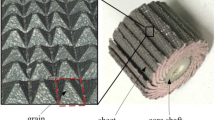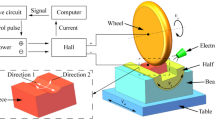Abstract
Since the curvature of free-form surfaces are variable, it is difficult to guarantee the quality of the surface polished with traditional polishing technology. The chief aim of this paper is to investigate the features of an original elastic polishing wheel device. The polishing trajectory of the elastic polishing wheel was simulated to study the relationship between the uniformity of a kind of polishing trajectory and the ratio of rotational speed “i” which is the ratio of the velocity of the rotation and the revolution. Orthogonal experiment was carried out to explore the effect of various factors (rotational ratio, press amount h, speed of rotation, and granularity of abrasive grains) on surface roughness polished. The writer has come to the conclusion that i has an influence on the uniformity of polishing trajectory. The polishing coefficient of variation “CV” of i = 10.645751 is 32% lower than i = 10. Increasing the number of digits after the decimal point of i, the polishing track performs more uniform and densely. The experimental tests show that the influence of rotational ratio, press amount h, speed of rotation, and granularity of abrasive grains on surface roughness polished decreases progressively.
Similar content being viewed by others
References
Cheng HB, Feng ZJ, Wang YW (2005) Deterministic polishing of smooth and structured molds. Science in China Press 50:172–178
Huissoon JP, Ismail F, Jafari A, Bedi S (2002) Automated polishing of die steel surfaces. Int J Adv Manuf Technol 19(4):285–290
Christian B, Roland T, Richard Z, Christian W (2010) Development of a force controlled orbital polishing head for free form surface finishing. Springer Verlag 4(2):269–277
Moumen M, Chaves-Jacob J, Bouaziz M (2016) Optimization of pre-polishing parameters on a 5-axis milling machine. Int J Adv Manuf Technol 85(1–4):443–454
Steffen H, Lars L (2012) Cycloids for polishing along double-spiral toolpaths in configuration space. Int J Adv Manuf Technol 60(1):343–356
Zhang L, Yuan CM, Zhou ZD, Chen YP, Modeling ZL (2002) Experimental study on surface removal of mould surface polishing. Chin J Mech Eng 12:98–102
Tsai MJ, Huang JF (2006) Efficient automatic polishing process with a new compliant abrasive tool. Int J Adv Manuf Technol 30(9–10):817–827
Ding JF, Li W, Yu FJ, Zhang KH (2006) Analysis and research on the polishing process of mold free-form surface. Mold Industry:67–71
Ji SM, Jin MS, Zhang X, Zhang L, Zhang Y, Yuan J (2007) New airbag polishing technology applied to mold free-form surfaces. J Mech Eng 8:2–6
Pan R, Wang ZZ, Wang CJ, Zhang DX, Xie YH, Guo YB (2013) Free-form surface optical element balloon polishing precession motion control technology. J Mech Eng 03:186–193
Ranjan P, Balasubramaniam R, Jain VK (2017) Analysis of magnetorheological fluid behavior in chemo-mechanical magnetorheological finishing (CMMRF) process. Precis Eng 49:122–135
Zhan J (2013) An improved polishing method by force controlling and its application in aspheric surfaces ballonet polishing. Int J Adv Manuf Technol 68(9–12):2253–2260
Shi F, Dai YF, Peng XQ, Wang Z (2010) Magnetorheological polishing to eliminate grinding sub-surface damage layer of new technology. Optical Precis Eng:168–174
Bai ZW, Yan QS, Xu XP (2015) Experimental study on plane polishing force characteristics of cluster magnetorheological effect. J Mech Eng 15:190–197
Ming SM, Zeng X, Jin MS, Tan DP, Dong J (2013) Analysis of processing methods and material removal characteristics of soft consolidation abrasive grains. J Mech Eng 5:173–181
Yu QS, Cheng Y, Hu SB (2013) Study on the processing method and material removal characteristics of soft consolidated particle group. J Mech Eng (5):173–181
Wu XJ, Sun SD (2011) Experimental study on correlation of grinding parameters of elastic abrasives. Mech Sci Technol 06:865–868
Tang J, Wang T, Chang Q, Zhang HT (2016) Design and analysis of flexible terminal actuator for mold polishing robot. Mech Des Manuf 02:263–266
Tian F, Li Z, Lv C, Liu G (2016) Polishing pressure investigations of robot automatic polishing on curved surfaces. Int J Adv Manuf Technol 87(1–4):639–646
Su JB, Liao HY, Su QS (2012) Research and development trend of robot mold polishing. Die Mold Ind 6:63–66
Wu XJ, Liu RP, Yu XZ, Wu Q (2015) Study on surface parameters model of M300 steel based on hertz theory. Surf Technol 6:109–114 119
Valentin LP Contact mechanics and friction physical principles and applications. Tsinghua University Press, Beijing, p 20
Reis VL, Daniel GB, Cavalca KL (2014) Dynamic analysis of a lubricated planar slider–crank mechanism considering friction and hertz contact effects. Mech Mach Theory 74:257–273
Zeng S, Blunt L (2014) An experimental study on the correlation of polishing force and material removal for bonnet polishing of cobalt chrome alloy. Int J Adv Manuf Technol 73(1–4):185–193
Funding
This project is financially supported by the National Natural Science Foundation of China (Grant No. 51375361 and No. 51475353). The authors are also grateful for the Industrial Research Projects of Shaanxi Province (2012K09-15).
Author information
Authors and Affiliations
Corresponding author
Ethics declarations
Conflict of interest
The authors declare that they have no conflicts of interest.
Rights and permissions
About this article
Cite this article
Wu, XJ., Tong, X. Study of trajectory and experiment on steel polishing with elastic polishing wheel device. Int J Adv Manuf Technol 97, 199–208 (2018). https://doi.org/10.1007/s00170-018-1905-1
Received:
Accepted:
Published:
Issue Date:
DOI: https://doi.org/10.1007/s00170-018-1905-1




